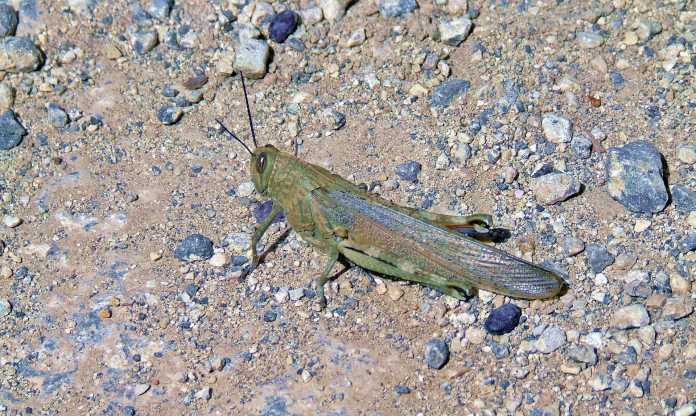Parts of India are undergoing their worst locust invasion in decades, following a cycle that has occurred throughout recorded history. Climate alarmists and their media ventriloquist dummies are claiming climate change must be to blame. They are lying.
“India is facing its worst desert locust invasion in nearly 30 years, and the climate crisis is partly to blame,” says an article published in Ecowatch. Nevertheless, the Ecowatch article presents no evidence this cyclical locust invasion is either caused by climate change or is especially severe compared to other historical locus invasions. The article presents no evidence to back up its assertion because no such evidence exists.
“Locusts are not uncommon in the northwest Indian state of Rajasthan, but this year they have also entered the states of Madhya Pradesh and Uttar Pradesh for the first time since 1993 and the state of Maharashtra for the first time since 1974,” writes Ecowatch. As the article admits, these events have happened repeatedly before, with the 1974 locust plague occurring during a 30-year global cooling period when the mainstream media were warning about a coming ice age.
Locust plagues have struck periodically, but with some regularity all over the globe throughout history. The Wikipedia entry on locust notes, “[t]he ancient Egyptians carved them on their tombs and the insects are mentioned in the Iliad, the Bible, and the Quran. Swarms have devastated crops and been a contributory cause of famines and human migrations.” And academic papers also show locust plagues have even been common across Europe, with one paper noting, “the history of locust plagues shows how pervasive plagues were, and when records are more complete in later history seemingly almost continuous in occurrence. If it was like this in Europe where the majority of historical records come from, how much more so must it have been in Africa where conditions were much more conducive to locusts?”
As a 2013 article in Farm Progress notes in the United States, “the speed, ferocity and devastation of locusts, particularly the Rocky Mountain locust, would have once been a fact of life for a sweep of American farmers from California to Texas to Minnesota.” The worst locust plague recorded in the United States since European colonization was recorded 1875, which was 150 years of global warming ago, during the late stages of the Little Ice Age. Farm Progress says:
“In 1875, the largest locust swarm in history was recorded over the Midwest — 198,000 square miles. (For a size reference, California covers 163,696 square miles.) The 1875 swarm was estimated to contain several trillion locusts and probably weighed several million tons. That was the largest locust cloud in world history, according to Jeffrey Lockwood, author of ‘The Devastating Rise and Mysterious Disappearance of the Insect that Shaped the American Frontier.’”
Abundant rainfall in recent years has brought more abundant water, crops, plants, and vegetation. This has benefited people, desirable wildlife, and locusts. The benefits of more water and food for all life do not become a crisis – or even a politically advantageous climate crisis, simply because locusts also benefit from better conditions for all life.
Another natural but, in some sense, unique factor contributing to the locus plague this year was its coincidental arrival with the COVID-19 pandemic. As Wikipedia notes, “recently, changes in agricultural practices and better surveillance of locations where swarms tend to originate, have meant that control measures can be used at an early stage. The traditional means of control are based on the use of insecticides from the ground or the air, but other methods using biological control are proving effective.” Amidst the Coronavirus pandemic and lockdowns, however, many of these normal monitoring and response mechanisms were abandoned.
A recent article in Wired discusses the problems that occurred with monitoring and response to the 2020 locust eruption. In Africa, where the current locust eruption first arose, above-average rainfall, heavy vegetation, and multiple years of good crop production made conditions ripe of the locust population boom.
The Global Locust Initiative at Arizona State University working with the U.N. Food and Agriculture Organization operate a network of monitoring and response teams across much of North Africa, the Middle East, and the Indian subcontinent. The current locust population explosion occurred in fairly wild and remote areas in the Middle East and Africa, areas with limited roads and infrastructure, and really erupted just as the Coronavirus shutdown was hitting. These factors combined to hamper locust monitoring and response across the region.
In other regions, political instability also prevented an effective response to the booming locust population. Yemen has been ravaged by years of war, leaving it unable no to deploy the specially trained crews the government had previously used to spray common pesticides that effectively kill locusts in mere hours. The ongoing civil war there also made it too dangerous for farmers and other regular folks to spray the pesticides themselves.
In short, myriad factors have contributed to the current locust plague striking large parts of Africa, Asia, and the Middle East, but there is no evidence that they are historically unusual. To the extent any particular weather or climate factors can be blamed, it would be weather and climate factors that greatly benefit humans, wildlife, vegetation, and crop production. Climate alarmists, however, don’t want people to hear that. Instead, the pick out the small downside and implicitly tell people that an ideal climate would be one of drought, crop failure, water shortages, and sparse plant growth to deprive food for locusts – and everything else.
Yeah, ok.


















[…] Read more at Climate Realism […]
[…] No, Climate Change Didn’t Invent Cyclical Locust Plagues […]